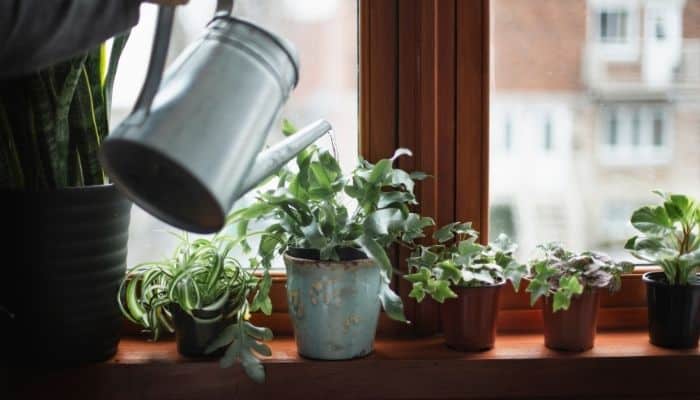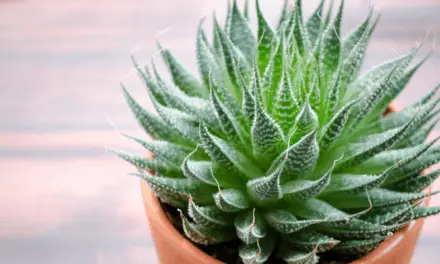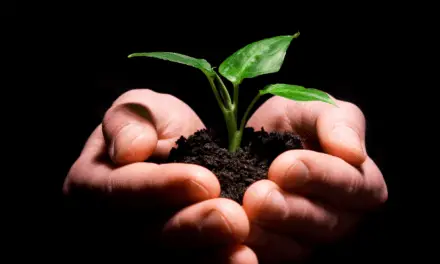During the winter months, your houseplants are going to need a lot of extra TLC.
Dealing with tough growing conditions, like low light, low humidity, and colder temperatures makes plants really easy to kill at this time of year.
During winter, your houseplant’s soil will not be drying out as fast as it would in summer.
Less intense sunlight and lower temperatures mean roots will need watering less often.
And bad watering practices can be even more detrimental to your plants during this time of year.
Table of Contents
How To Water Your Houseplants In Winter

How you water your plants in winter will depend on the type of plants you have and how wintery the conditions are.
Generally, the growth of most plants slows during the winter months so it is best to cut back on watering until spring comes around and they begin to grow again.
However, you should still follow the general rules regarding your plant’s care and find out whether any of your plant types go dormant in winter.
If so, they will require even less water than plants that do not go dormant.
For succulents, only water when their soil has completely dried out and for cactus plants, you can stop watering altogether over the winter months.
The exception is plants that flower over winter, such as winter jasmine and pansies, which should be watered when the top one or two inches of soil dries out.
Check The Soil Is Dry
If your plant likes its soil to completely dry out between watering times then this rule applies both in summer and in winter.
The only difference is that it will take longer for the soil to dry out in winter so you will be watering your plant less to achieve the same moisture consistency within the soil.
Just as you would in summer, test the top two or three inches of soil with your finger and water as you would normally.
If your plant usually likes to be watered when the top two inches of soil completely dry out then that’s how you should water it all year round – unless it goes dormant, can you may be able to leave it dry out for longer.
Related Article: Can Plants Grow Without Water?
Check If The Pot Feels Light
You can also lift your plant’s pot and if it feels much lighter than usual, it’s a good indication that the soil is lacking moisture and could do with watering.
Water When Your Plant Droops
Other than dry soil, many plants will give us a sign when they want to be watered.
Certain plants, such as the peace lily, will wilt or droop their leaves when they are in need of water.
But plants can also droop for other reasons, like pest infestations and even overwatering, so only judge watering needs by drooping if you have experience.
The safest way is to check the soil’s dryness with your finger and water your plant as you would in summer.
What If My Plant Goes Dormant In Winter
Dormant plants often stop growing completely and may need even less water – too much and they’ll rot as water builds up in their pot.
Only give some water when the soil becomes bone-dry.
How Often Should I Water Indoor Plants In Winter?
The two biggest issues for your plants during winter are lower temperatures and lower levels of sunlight.
If your plant flowers in winter or if you live somewhere where there are extremely mild and short winters or you are providing your plants with lots of artificial light, warmth, and humidity, you may not need to water them a whole lot less than what you would in summer.
However, if your winters are colder and darker and your plants don’t live under grow lights, you’ll need to water sparingly.
Water provides higher levels of oxygen for your plant to photosynthesize.
And in the shorter days of the winter months, your plant won’t be photosynthesizing as much.
Because your plant doesn’t need it, the water is more likely to sit in the soil and cause root rot.
When watering during winter it is usually best to allow your plants to dry out even more between waterings than you would in summer.
Test the soil in your plant’s pot with your finger and only give water when it feels dry.
What Is The Safest Way To Water Houseplants In Winter
The safest way to water plants in the wintertime is from the bottom up.
Because plants don’t grow as much in winter and don’t have as much need for water they are more prone to root rot.
When you water from the bottom up it ensures that the soil becomes saturated and the roots have access to enough water.
This way, you can – with confidence – allow the soil to dry out to the level that your plant likes before you give it more water.
Put your plant into a large container and water from the top until there are a few inches of water around the bottom of your plant’s pot.
Allow your plant to sit there for 15 or 20 minutes so that can absorb lots of water.
Then take your plant out and put it somewhere where the water can drain out of your pot’s drainage holes and allow the soil to begin drying.
Watering from the bottom also encourages your plant’s roots to grow towards the moisture and deeper into the pot, making the root structure stronger.
It also ensures that roots at the very bottom of the root structure receive enough water.
Use Water That Is At Room Temperature
Even in the summer, watering your plants with water that is too cold can shock their roots and cause stress.
And doing so in winter can be even more harmful because your plant is already growing in less than ideal conditions.
Before watering, filter tap water and leave it to sit in a container in the room for 24-hours to allow its temperature to rise.
Test it with your finger and if it still feels a little cold, add a bit of warm water to it.
Do Plants Need Less Water In Winter?
Yes, plants usually need less water in winter because they photosynthesize less and have less need for water.
This does not mean that plants like their soil to become drier than usual in winter, it just means the soil takes longer to dry out because conditions are colder and the plant is absorbing less water.
However, if your winters are very mild or if your plants flower in winter, they will need to be watered when their soil becomes dry.
Should You Mist Plants In Winter?
If you have a plant – like a spider plant – that will benefit from extra humidity, then raising the humidity in its environment will help to ease stress.
But there is not much point misting your plants in winter unless you plan on doing it every 15-minutes, day in and day out.
After about 15 or 20 minutes, once the water has evaporated from your plant’s leaves, the benefits of misting are gone.
If you have a tropical plant and need to raise humidity levels, you are better off moving it to a bathroom, buying a humidifier and keeping it nearby, or grouping your plants close to other plans to raise humidity.
Final Thoughts
Due to cold and low light, most plants are under additional stress during the winter months.
And when you don’t take care to water your plants correctly, you can easily end up adding to those stresses.
Try to do a little research on your plant and find out about its native environmental conditions during the winter months.
This will give you loads of clothes about how your plant likes to be cared for when it’s not actively growing.
Other than that, your safest bet is to only give water when the soil has dried out and to take extra care not to overwater.




